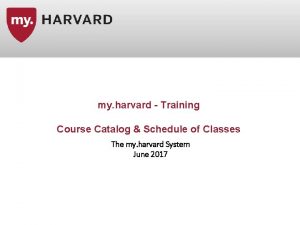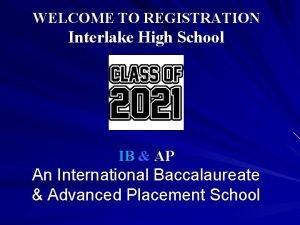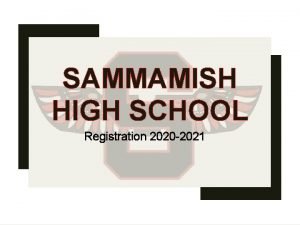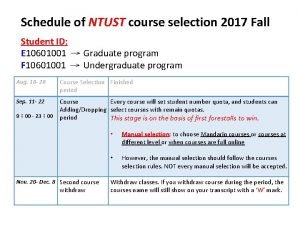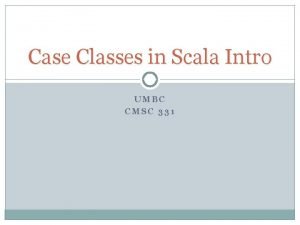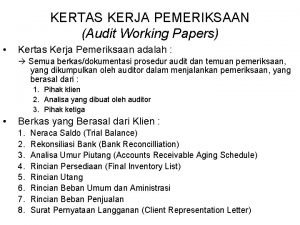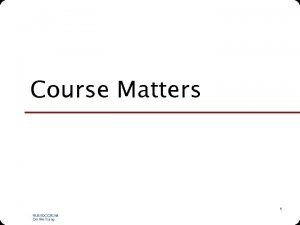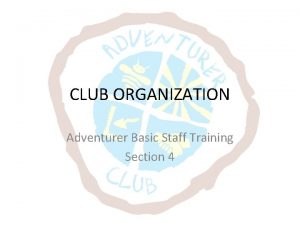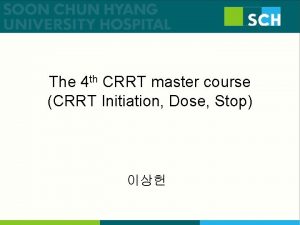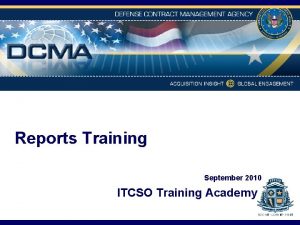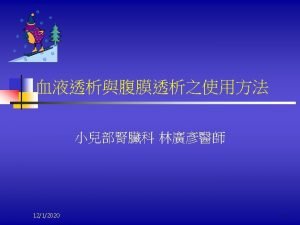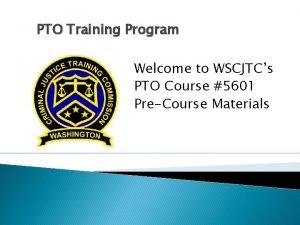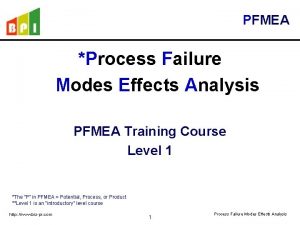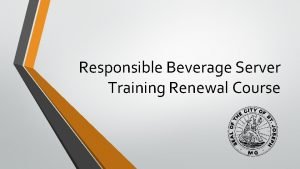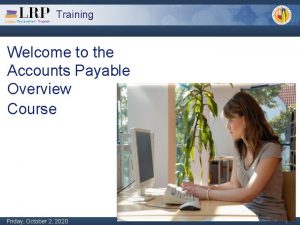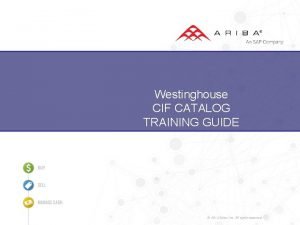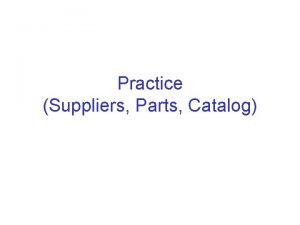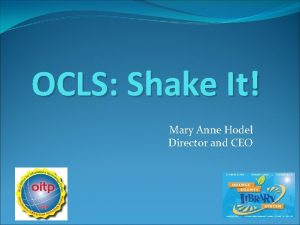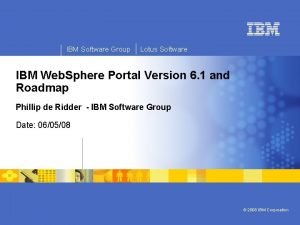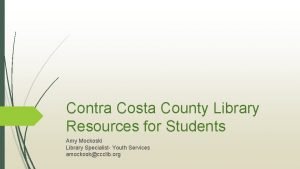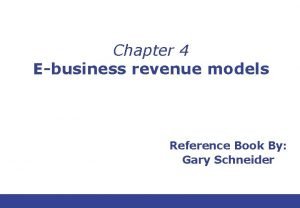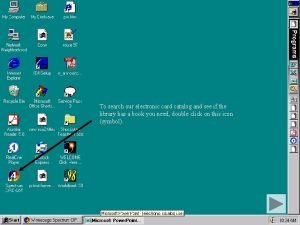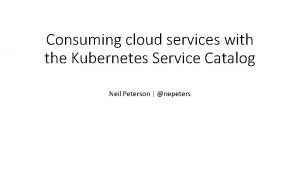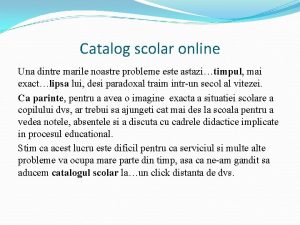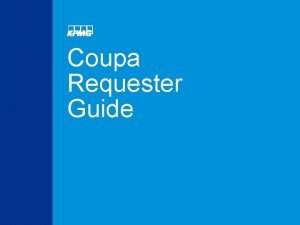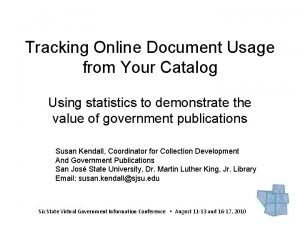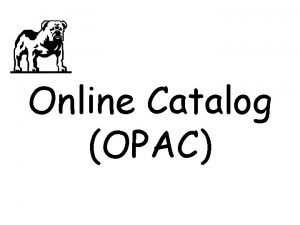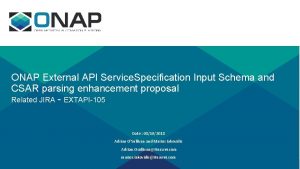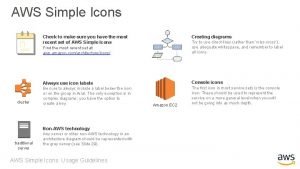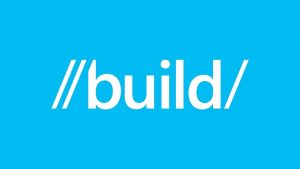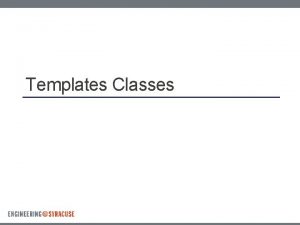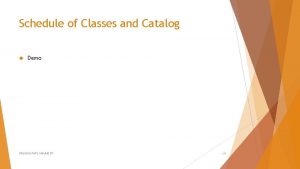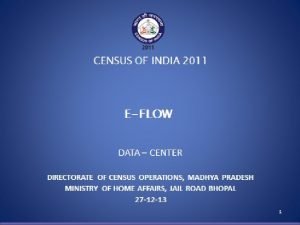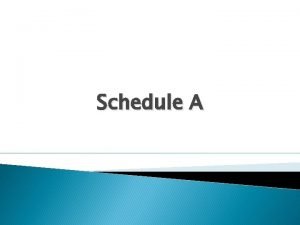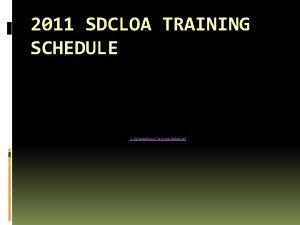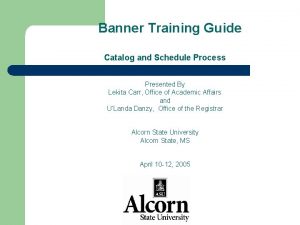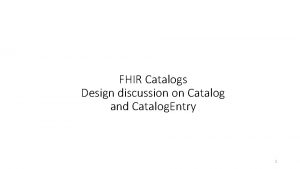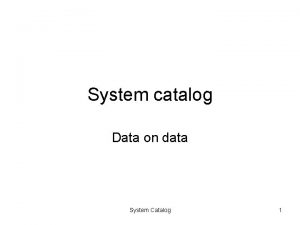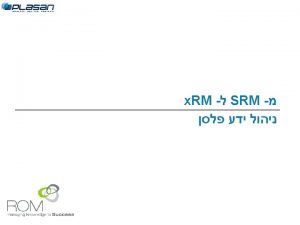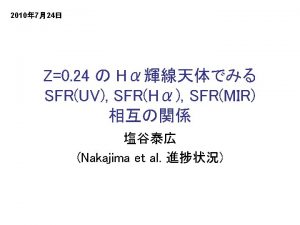my harvard Training Course Catalog Schedule of Classes






























































































- Slides: 94

my. harvard - Training Course Catalog & Schedule of Classes The my. harvard System June 2017

Objectives • Quick Introduction: my. harvard • Accessing my. harvard • my. harvard - portal: The View from Course Search • Active and Bracketed Courses • my. harvard – admin: Basic Navigation and Adding a Favorite • my. harvard – admin: Review/Modify Existing Course Schedules • my. harvard – admin: Review/Modify Existing Catalog Records • my. harvard – admin: Create a New Course and Schedule • my. harvard – admin: Modifying Courses • Bracketing a Course • Retiring a Course • my. harvard – admin: Specific Modification Scenarios • Where to Get Help 2

Overview

Overview - Features Students: • • my. harvard Check in online Update personal information Find great classes Submit crimson cart Engage with advisors Add/drop/swap courses View grades, bills and holds … one unified, intuitive portal Faculty: • • • Upload grades Access class rosters Certify degree & program requirements Calculate GPA View enrollment statistics Track course trends Advising: • • Foster advising relationships Access comprehensive advisee information 4

Accessing my. harvard

Logging Into my. harvard Access: Student, Faculty & Some Staff functions General Public access to the Course Catalog Where staff can create and edit courses and perform other admin activities 6

my. harvard – The View from Course Search

Understanding the my. harvard Header Provide feedback or get assistance from these links Set Preferences such as School Save Favorite Courses Shows faculty/advisors pending to-do items, e. g. , signing off the Crimson Cart Tabs Overview: Student Home available only to active students Teaching & Advising Center is key tab for faculty and advisors Course Search visible to ALL students, faculty, and staff Other Resources & Quick Links provide access to external resources

Other Resources This menu provides a set of external links relevant to each user population; the list will evolve over time but we seek to emphasize the most important resources. 9

Quick Links 1 2 3 4 1 My Current Courses: Will show user’s Canvas sites 2 Manage My Quick Links: To remove or change links over time 3 Add External Link: If the site uses Harvard Authentication Services (PIN) the login should be seamless 4 Add Current Link: Can bookmark course search or advisee search parameters, making it really easy to repeat frequent searches 10

Course Search – Home Page Step 1: Search for Courses Click Course Search if you do not immediately land on Course Search after log in Select Advanced Search to narrow search by school, term, instructor, etc. Select a school to narrow down by school-specified criteria 11

Course Search-Search Options Set User Preferences to narrow choices to specific school, etc. Keyword search* Advanced search: narrow by school, subject, instructor, etc. * Browse All FAS courses by a variety of different criteria* *You can save search results as a Quick Links to return to later! 12

User Preferences - Set Your Preferred School - Set your Default Sort Order - Set some Advanced Search Options 13

User Preferences Once preferences are set defaults will appear for your school 14

Advanced Search Select FAS or user preference to default to FAS preset here, based on setting using preferences; will be blank otherwise FAS Additional Attributes allow students to narrow by Course Level (undergraduate or graduate), or General Education; these were expanded here by setting user preferences 15

Course Search Click on the Plus sign to expand facets Advanced Search Select course to view details Filter by Department or Subject Filter by Course Attributes Filter by Course Component (lecture, seminar, etc. ) 16

Course Search - Course Details View Canvas Site (note: must have access) View Course materials at Harvard Coop During Enrollment, Student clicks to add to Crimson Cart Add to Favorites List to consider later Click on Instructor drop down to see all courses being taught by instructor Note: the Course Site, Harvard Coop, Add to Crimson Cart and Save to Favorites will NOT appear if you are searching the general public course catalog 17

Course Search - Course Details View Course materials at Harvard Coop During Enrollment, Student clicks to add to Crimson Cart Add to Favorites List to consider later Course Title Term, Day(s)/Times Subject Area and Catalog Nbr (local course number) Course Description Class # (unique to term); Course ID (unique to course); Instructor Consent; Enrollment numbers; waitlist numbers Course Notes, if appropriate Class Notes, if appropriate School, Units (credits); availability for Cross Registration; Course Level Department, Component, Exam/Final Deadline, Final Assessment Category Subject, Grading Basis; General Education 18

Bracketed Courses What is a “bracketed” course? • In Course Search, a bracketed course is a course that is taught by a professor in your department but is not being offered in the current academic year. • The faculty member may be on leave or simply decided not to teach the course this year • The faculty member may have left the University, and another professor has not yet been chosen to teach the course • A bracketed course informs students that a course exists—the student may use this information to plan to take the course in the future • The student can save such course as a Favorite • The student can add it to their Plan of Study • The course is identified in the catalog by having brackets around the title • The course will indicate that it is “Not Offered” for the current academic year 19

my. harvard – admin Basic Navigation & Creating a Favorite

my. harvard admin homepage • You will see a series of folders on the left-hand side of the screen • You will only be able to access the folders for which you have been granted access. 21

Persistent Links • Access and edit your list of favorite pages • Access other pages from anywhere in the system • Clicking Home will return you to homepage from anywhere in the system • Add a favorite page • Sign out 22

Navigating to Schedule of Classes • Click on arrow next to Curriculum Management • Then click on the arrow next to Schedule of Classes • Then click the Maintain Schedule of Classes link 23

Schedule of Classes Homepage • You can search by a variety of fields for your course • Requires you to enter a Term 24

Add Schedule of Classes Homepage as a Favorite 1. Select Add to Favorites. 2. Click OK. 3. Click OK. 4. Page added to Favorites list. 25

my. harvard – admin Curriculum Management

my. harvard. edu or Campus Solutions? You will often hear “my. harvard” or “Campus Solutions” when there is a reference to the Course Catalog my. harvard portal my. harvard administration my. harvard portal • Student Home • Course Search • Teaching/Advising • Other Resources my. harvard administration … is powered by Campus Solutions (vendor name of product) • Course Catalog • Schedule of Classes • Enrollment • Billing 27

Vocabulary • Section - Individual parts of a class in Schedule of Classes often have multiple sections. A section may be a lecture, lab, discussion, etc. • Primary Component - The main course delivery instruction methodlecture, seminar, etc. Ex: lecture/discussion class--lecture is primary component. Most courses have one primary component. • Secondary Component - The secondary (though often required) instruction method. Discussions, labs, films=secondary components. – Placeholder Section - A type of secondary component of a class (DIS, LAB). Students must enroll in placeholder section in order to be divided among discussion or lab sections within the sectioning tool. A Placeholder section will be sectioned further in the Sectioning Tool. • “Inactivate” a Course - Courses are marked Inactive when the course is no longer being taught. In the past, this was referred to as “retiring” a course. Course is made inactive in the Catalog 28

“Copied Prior Term” What is Copied Prior Term ? • Schedules for classes offered in the previous Fall and Spring are recreated for the upcoming Fall and Spring by Copied Prior Term (Registrar’s Office function) • Since courses are copied from year to year, we recommend starting your annual course maintenance by: – Reviewing the Copied Prior Term courses – Making edits as needed (edit, make inactive, bracket) – Creating any new courses and schedule When Classes are Copied Prior Term: • The entire academic year is copied—Fall and Spring, at the same time • Certain information is copied with the courses—Teaching Fellows and all secondary components • Usually, the Teaching Fellows and Assistants are removed by the SIS Team • You have the option of deleting any copied sections you do not wish to use 29

Curriculum Management is the area of my. harvard that creates and maintains the following components: Course Catalog Schedule of Classes Enrollment Requirements (Prerequisites) Curriculum Management directly impacts Academic Advising Collectively, the components within Curriculum Management are the initial building blocks for Student Records. 30

Relationships between Areas Course Catalog (Inventory of all Courses) Academic Advising (Uses courses and schedule to advise students) Schedule of Classes Enroll (Specific offering of the course) (Students enroll in a scheduled class of a Course) After a Course has been scheduled and students have enrolled, changes to the Course Catalog MAY impact the Schedule, Enrollment, and Academic Advising 31

Course Catalog & Schedule of Classes Course Catalog Schedule of Classes Template that includes primarily unchanging Course information Template that includes specific offering of the Course Use the Course Catalog Template to add e. g. : • Subject and Course Number • Course Description • Number of Credits • Discussion or Lab • Gen Ed Requirements Use the Schedule of Classes Template to add e. g. : • Logistics (e. g. Time, Meeting Schedule) • Rooms • Instructor 32

Recommended Course Maintenance Workflows

Overview of a Recommended Workflow – Start in the Schedule of Classes: The schedule displays nearly all courses that were/are being taught in the previous academic year and have been copied to the current year (Copied Prior Term). 1. Review Courses 2. Remove unnecessary schedules 3. Create New 4. Check Classes and Bracketed Schedule Courses • • • If necessary, make edits to meeting times, instructors, etc. • If course will not be offered in the current term, but will be offered in the future: Bracket the course If course will never be offered again: Inactivate the course Create brand new courses in the Course Catalog and create Schedule for new classes • • If a course has been bracketed for last term, should it be available this term? If yes, un-bracket the course and schedule for the upcoming term Workflows have been created for all of these scenarios 34

Scenario 1: Copied Prior Term Course will be Taught in the Upcoming Term

Schedule of Classes The Schedule of Classes defines how the Course will be managed in the upcoming term • Holds Term Specific Information The Schedule of Classes Template uses the Course Catalog Template information and adds additional logistical information 36

Structure of the Schedule of Classes A Term is indicated by a Term Code which is a 4 digit number: • 1 st digit is the Millennium (1 = 1900’s and 2 = 2000’s) • 2 nd and 3 rd digits are the last two digits of the Year (e. g. , 16 for 2016) • 4 th digit is the Month in which the term begins: 2 = Spring 6 = Summer 8 = Fall (Spring Semester Starts ~ February) (Summer Semester Starts ~ June) (Fall Semester Starts ~ August) 37

Maintain Schedule of Classes Search page 1. Enter the Term value 2. Enter Subject Area 3. Click Search 4. Select a course from the Search Results 38

Schedule of Classes Record 1. Basic Data tab describes the term, school ownership, holiday schedule, instruction mode 2. Meetings tab is used to set the class meeting pattern and add instructors 3. Enrollment control tab governs instructor consent, enrollment & room capacity, & waitlist options (note: waitlist not yet in use at FAS) 39

Schedule of Classes Record 4. Reserve Capacity tab allows you to set enrollment rates based on specific criteria, e. g. , “X number of seniors”not yet in use by FAS 5. Notes tab allows you to add Class Notesnotes specific to the term 6. Exam tab indicates date and time of final exams-completed by Registrar 7. LMS Data, Textbook and GL Interface tabs -not currently in use at Harvard 40

Schedule of Classes Record- Basic Data Tab Checklist On Basic Data Tab: q Check that the Component is correct* q Check to see if there any secondary components (Discussion, Labs, etc. )* q Be sure that Schedule Print and Student Specific Permissions boxes are checked. ^ q Leave Start/End Date as is—changing dates will result in course NOT rolling next year! q If you use Course Topics, make sure the Topic is listed. * q Check Class Attributes and make sure those are accurate. * * Display in Course Search • See workflows for information on how to edit Course Topics and Attributes ^Boxes should be checked for primary and first secondary sections only. 41

Schedule of Classes Record- Meetings Tab Checklist On Meetings Tab: q Checking Meeting Days and Times. Edit if you need to change. * If there are multiple meeting times, confirm or change all as needed q Do not edit Facility ID-if you need to change a room, do this in Room. Book q Do not change Start/End Date-class will not Copy Term Roll to next year! q Check Instructor(s) and make sure information is correct. Confirm Role and Access information is correct. Edit if necessary. * * Display in Course Search See workflows for information on how to edit Meeting Times and Instructors. 42

Faculty Roles – Used by FAS Instructor Role FAS Definition Prints in Allowable Course Search Grade Access Head Instructor, multiple Head Instructors okay Yes Must be Post Access Instructor, not Course Head Yes Grade, Approve TA, TF Teaching Assistant or Teaching Fellow No Leave Blank Crse Director Administrator directing administration of course No Grade, Approve Grade Administrator supporting course (faculty assistant) No Grade 43

Faculty Roles – Not Used by FAS Instructor Role FAS Definition Print in Course Search Allowable Grade Access Prim Instr Primary Instructor No N/A Sec Instr Secondary Instructor No N/A Preceptor No N/A 44

Schedule of Classes Record-Enrollment Cntrl Tab Checklist On Enrollment Control Tab: q Confirm Instructor Consent information is correct. * q Confirm Room Capacity contains a reasonable room size number. q Confirm correct Enrollment Capacity: * • 999 if unlimited enrollment • Exact number if limited enrollment See workflows for information on how to edit Instructor Consent, Room Capacity and Enrollment Capacity fields. • Be sure that the enrollment for any placeholder secondary components matches the Lecture enrollment capacity. This is to avoid enrollment issues. * Displays in Course Search 45

Schedule of Classes Record- Notes Tab Checklist On Notes Tab: q Review any existing notes and make any changes, if appropriate. * Notes are not required. Any notes added to this tab should be termspecific. If you need to add a permanent course note, you will do this in the Course Catalog Record. See workflows for information on how to edit class notes. * Displays in Course Search FAS does not currently use Reserve Cap, Exam, LMS Data, Textbook and GL Interface tabs If you have made any changes to the Schedule Record, click Save!! 46

Navigate to Catalog Record You will now review the Catalog Record for your course Using the breadcrumbs, navigate to Curriculum Management>>Course Catalog 47

Course Catalog The Course Catalog Template holds the “Most common level of information” on the course • contains Course information that should be consistent over time 48

Course Catalog The Course Catalog is needed to Build Enforce Schedule of Classes Enrollment Requirements (Prerequisites) Impact Academic Advising functionality Changes to the Course Catalog do not automatically update an Existing Schedule 49

Course Catalog When you move from the Schedule Record to the Course Record, the Course information will automatically populate the Catalog Search record. Click Search. 50

Course Catalog Why multiple search results? Because this course has changed its title over its history. You will need to be mindful of titles—you can look at the course in Course Search or return to the Schedule Record—if you then navigate to Course Catalog from here, it will pick the correct record. 51

Course Catalog Data Tab: Course Title, Description, Units, Grading Basis, Repeatable, Instructor Consent, Attributes, Course Notes and Course Topics Offerings Tab: Subject and Catalog Number, Department Ownership and Prerequisites Components Tab: Components Course Milestone Link and GL Interface Tabs: Not in Use at Harvard 52

Course Catalog-Effective Date Unlike the Schedule Record, if you need to make changes to the Catalog Record, you may need to unlock the record before editing Recommended Effective Dates: • For Fall Courses: 8/15/XXXX, where XXXX is the appropriate year • For Spring Courses: 1/15/XX, where XXXX is the appropriate year Click + sign to unlock record. Change Effective Date to appropriate date Once you change the date, you can continue to edit the record without unlocking again until the date you have set! 53

Course Catalog On Catalog Data Tab: q Check Long Course Title and Long Description* q Check that Units are correct* q Check that grading basis is correct* q Check if course is repeatable q Check Instructor Consent* q Check attributes* q Check Course Notes, Recommended Preparation, Keywords* q Check Course Topics* * All display in Course Search • See workflows if you need to edit any of these values 54

Course Catalog On Offerings Tab: q Check Subject and Catalog Nbr. * q Check Academic Group, Organization and Career* q Check for Prerequisites (Enrollment Requirement Group). If it exists, confirm it is correct. If it doesn’t and you need a prerequisite, contact the Registrar’s Office* q Check that Course Approved field is Approved See workflows if you need to edit any of these values q Check that Allow Course to be Scheduled, Catalog Print, Print Instructor in Schedule, Schedule Print and Schedule Term Roll boxes are checked off * All display in Course Search 55

Course Catalog On Components Tab: q Check Components (Lecture, Seminar, etc. )* q Check secondary components, if any (Discussion, Lab, etc. )* q Check Default Section Size q Check that Final Exam is set to Yes for the Primary Component q Check that Exam Seat Spacing is set to 2 * All display in Course Search See workflows if you need to edit any of these values If you have made any changes to the Catalog Record, click Save!! 56

Course Catalog-Reminders Cautions concerning editing: • If a Schedule Record exists, any change you make in the Course Catalog will NOT automatically update the Schedule Record • Depending on what you are changing, you may need to edit multiple records to make sure that all of your changes are accurately recorded and capable of displaying in Course Search • See the Workflows for the steps you need to edit a specific field in the Catalog Record. Note that this ONLY applies to records where a Schedule Record exists. If you are creating a NEW course, the values will carry over to the new Schedule. After editing the Course Catalog Record, be sure to click Save to save your changes! 57

Scenario 2: Copied Prior Term Course will be Bracketed or Unbracketed in the Upcoming Term

Bracketing Courses • All courses that have an Active status and Catalog Print checkbox checked in the Course Catalog will appear as bracketed in the my. harvard Course Search • Active courses that are not scheduled will appear in my. harvard – automatically – as bracketed courses 59

How to Bracket a Course Scenario: Bracket a Course for next term that is currently being taught: 1. Delete and Save the Schedule Record 2. On the Catalog Record, Catalog Data (first) tab, Change the Effective Date to 8/15/XXXX for Fall or 1/15/XXXX if you are bracketing for the Spring by clicking the + sign to the right of the Status field 3. Navigate to the HU Additional Course Catalog Attribute Field and select Instructor. This is important as the Instructor only appears on the schedule record, which you have just deleted. 4. Best Practice Recommendation: Add Next Term Offered so students can be aided in planning. Click the + sign to add the field. 5. Save the Record. See the Workflows for step-by-steps 60

Deleting Schedule Records To delete a Schedule Record: 1. Bring up the record 2. On the Basic Data tab, click on the minus sign next to the Term Date – If there are multiple sections, delete those using the same method 3. Save the record 61

Continue Bracketing a Course Scenario: Continue to bracket a currently bracketed course: 1. There will be no schedule record, because the course is already bracketed. Thus, search for the course in the Course Catalog. 2. On the Catalog Record, Catalog Data (first) tab, Change the Effective Date to 8/15/XXXX for Fall or 1/15/XXXX if you are bracketing for the Spring by clicking the + sign to the right of the Status field 3. Best Practice Recommendation: Update the Next Term Offered so students can be aided in planning. 4. Save the Record 62

How to Un-Bracket a Course Scenario: Un-Bracket a course bracketed for the current Term (i. e. , course bracketed for current academic year will be taught in next term): 1. Open the Course Catalog Record 2. On the Catalog Data (first) tab, Change the Effective Date to 8/15/XXXX for Fall or 1/15/XXXX for Spring by clicking the + sign to the right of the Status field 3. Delete the Next Term Offered and Instructor from the HU Additional Course Catalog Attribute Fields 4. Save the Record 5. Navigate to Schedule of Classes>>Schedule New Course 6. Create Schedule for appropriate Term 7. Save the Record 63

Scenario 3: Copied Prior Term Course will be Made Inactive (“retired”)

Making a Course Inactive (“retire” a course) If the course is not going to be taught again: 1. Delete and Save the Schedule Record 2. Navigate to the Course Catalog Record 3. On the Catalog Data (first) tab, change the Effective Date to 8/15/XX for Fall or 1/15/XX for Spring by clicking the + sign to the right of the Status field 4. Change the Status from Active to Inactive 5. Save the record Remember: You can always re-activate a course! 65

Inactivate a Currently Bracketed Course Scenario 2: Inactivate a currently bracketed course: 1. Open the Course Catalog Record 2. On the Catalog Data (first) tab, change the Effective Date to 8/15/XXXX for Fall or 1/15/XXXX for Spring by clicking the + sign to the right of the Status field 3. Change the Status field from Active to Inactive 4. Delete the Next Term Offered and Instructor from the HU Additional Course Catalog Attribute Fields 5. Save the Record 66

my. harvard – admin Create a New Course

Add a New Course 1. Click Add a New Value link 2. Leave Course ID as all zero’s 3. Click Add See the Workflows for step-by-steps 68

Add New Course - Catalog Data Tab On Catalog Data Tab: q Add the correct Effective Date q Leave Status Active q Add Description (<= 30 characters) q Add Long Course Title (<=100 characters) q Add Course Description (<=4, 000 characters) q Add Units (most FAS classes are 4) q Add Grading Basis (most FAS classes are Letter Graded) q If appropriate, add repeatable value q If appropriate, add instructor consent q Add Attributes: Level, XREG (YES), Divisional Distribution q If appropriate, Course Notes and/or Recommended Preparation and/or Keywords q If appropriate, add Course Topic • See Create New Course workflow 69

Add New Course – Offerings Tab On Offerings Tab: q Add Catalog Nbr. q Add Academic Group (FAS) q Add Subject Area (will fill in Academic Organization field) q Add Campus (FAS) q Add Academic Organization q Add Academic Career q Set Course Typically Offered value q Set Course Approved to Approved Note: Campus should always be FAS, even if course is taught in Longwood or Allston! Contact the RO if you need a prerequisite for your course. q Verify that Allow Course to be Scheduled, Catalog Print, Print Instructor in Schedule, Schedule Print and Schedule Term Roll boxes are all checked q If appropriate, add Enrollment Requirements (prerequisites) 70

Add New Course – Components Tab On Components Tab: q Add primary component (Lecture, Seminar, etc. ) q If appropriate, add any secondary components q Check Default Section Size and change to 999 or to exact number if class is limited enrollment q Check that Final Exam is set to Yes for the primary component; No for secondary components See next slide if you need to add a secondary component After adding all information, click Save to Save the Record! 71

Add New Course – Components Tab Add a Secondary Component How to Add a Secondary Component 1. Click + Sign to Add a new blank row 2. Select Component type (Discussion, Laboratory, etc. ) 3. Make sure Default Section Size matches that of the Primary Component 4. Check that Final Exam is set to No 5. Check off the Auto Create checkbox After adding all information, click Save to Save the Record! 72

Navigating to the Schedule of Classes 1. At the top of the page, select Curriculum Management 2. Schedule of Classes 3. Schedule New Course 73

Schedule New Course Search page 1. The system will bring over course information from the Course Catalog Record 2. Enter the Term value 3. Click Search 74

Schedule New Course – Basic Data Tab On Basic Data Tab: q Add 1 to Session field for Full Term q Enter 001 for the first class section of the primary component q Be sure that Schedule Print and Student Specific Permissions boxes are checked. ^ q Leave Start/End Date as is—changing dates will result in course NOT rolling next year! q If appropriate, add the Course Topic q Check that the Class Attributes Level, XREG, and Divisional Distribution appear ^Boxes should be checked for primary and first secondary sections only. 75

Schedule New Course – Meetings Tab On Meetings Tab: q Select Meeting Pattern and add Meeting Times^ q Note that Meeting times added by pattern automatically shaves 1 minute off the hour/half hour q If you do not use a meeting pattern, be sure to shave 1 minute off the hour/half hour q Add Instructors for Meeting Patterns. Click the lookup to search by name. ^ * ^Not required to create record; you can add this information later. *If you do not find your instructor, see the workflows for information on how to add an instructor. *If the instructor is a visitor, there may be a time lag between when the instructor obtains his/her HUID and when the information will be available in my. harvard. q Add Instructor Role^ (see slide 43) q Add Access^ (see slide 44) Use the + sign to additional instructors 76

Schedule New Course – Enrollment Cntrl Tab On Enrollment Cntrl Tab: q Confirm Instructor Consent information is correct. q Add a reasonable size room Number. q Confirm correct Enrollment Capacity: * • 999 if unlimited enrollment • Exact number if limited enrollment 77

Schedule New Class – Notes Tab On Notes Tab: q Add a free text note, if appropriate Notes are not required. Any notes added to this tab should be termspecific. If you need to add a permanent course note, you will do this in the Course Catalog Record. After adding information to the Schedule Record, click Save!! 78

Schedule of Classes: Secondary Components Naming Standard • If a course has a secondary component (or multiple components) e. g. , a lecture and a lab, film or discussion, a placeholder component has to be set up. • When you create your secondary components, please apply the following naming standard: • DIS: placeholder discussion • LAB: placeholder lab • FILM: placeholder film • This will help us to identify the placeholder component quickly! • Please Note: When you create a placeholder component in the course catalog (e. g. , lab), then the course must be scheduled in the Schedule of classes. 79

Schedule New Course – Add Secondary Component On Basic Data Tab: q Click Auto Create Component button q Enter 1 in the session field for the Full Term q Enter appropriate naming convention in Class Section field q Make sure Schedule Print and Student Specific Permissions boxes are checked off. q Save the record. After adding information to the Schedule Record, click Save!! 80

my. harvard – admin Course Updates

Modifying Courses • There are several ways to modify a course, and depending on what you need to do, you may have to take few or several steps • For example, changing a meeting time and/or instructor is very simple – simply open the Schedule record and make the change • Other changes require more steps. For example, changing a component from Lecture to Seminar or vice versa involves changes to the Course Catalog Record, and an intervening record called “Adjust Class Associations” as well as the Schedule Record • Workflows exist to assist you with these efforts, and the Registrar’s Office offers many job aids to assist in the modification of more complex record changes Bottom Line: Do NOT assume that any change you make in the Catalog Record will automatically update the Schedule Record. 82

Course Updates Ask Yourself……. Does a Schedule Record exist for the Course? NO YES Information from the Catalog Record will pre-populate many fields in the Schedule Record The path(s) you will need to take to edit the course and schedule will vary on the field(s) you wish to change Covered in previous section See next set of slides and workflow documents 83

Course Update Paths Catalog Record Only Schedule Record Only Both Catalog and Schedule record Adjust Class Associations Roll Curriculum Data Forward 84

Course Update Path: Update to the Catalog Record Only Catalog Record Updates: • • Course Description Course Keywords Course Notes Recommended Preparation Update Catalog Record Review Change in Course Search or Preview Changes to the Course Search take 24 hours to change in Course Search 85

Course Update Path: Update to the Schedule Record Only Schedule Record Updates: • • • Meeting Patterns Instructor(s) Enrollment Capacity Room Capacity Class Notes Update Schedul e Record Review Change in Course Search Preview Changes to the Schedule Record are Updated each ½ hour in Course Search 86

Course Update Path: Update to the Schedule Record Only Catalog & Schedule Record Updates: • Instructor Consent • Course Attributes Update Catalog Record Update Schedule Record Review Change in Course Search Preview System Relies on Change Made in the Schedule Record. Updated each ½ hour in Course Search 87

Course Update Path: Roll Curriculum Data Forward: • • Any fields on the Offerings Tab, such as: Course Title (“Long Title”) Catalog Nbr. Academic Organization Academic Group Academic Career Subject Campus Update Catalog Record Roll Curriculum Data Forward Confirm Change in Schedule Record Review Change in Course Search or Preview Since Updates are to the Course Catalog, change will be reflected 24 hours later in Course Search 88

Course Update Path: Adjust Class Associations: • • Course Units Grading Basis Changes to the Primary Component (Lecture, Seminar, etc. ) Changes or addition of a Secondary Component (Discussion, Laboratory, Film, etc. ) Update Catalog Record Adjust Class Associations Confirm Change or Update Schedule Record Review Change in Course Search Preview System Relies on Change Made in the Schedule Record. Updated each ½ hour in Course Search 89

my. harvard – admin Special Scenarios

What to do if a Class is not Copied Prior Term? Why isn’t the Class Copied Prior Term? • The data for the primary component was not consistent between the catalog and the schedule of classes What to Do: Ensure accuracy of primary component in the Catalog & Schedule a New Class What if there is incomplete data on the Schedule? • Dates on the Meeting tab do not match the dates for the Term—course will be Copied Prior Term, but the Meeting Times will be empty What to Do: Where meeting times are empty, add the meeting times back in What if a cancelled section will be offered this upcoming year? • Canceled sections are not Copied Prior Term. What to Do: Schedule a New Class 91

Special Scenarios • Course Search Preview: In the Spring, while you are preparing courses for the upcoming academic year, it is possible to use a function known as Course Search Preview to preview your courses before the Catalog is released in June • Full Year Courses: There are special processes for create a course that is offered for the entire academic year • Language Courses: There are options for how to set up courses for languages. See the Registrar’s Office website for a job aid. • Combined Sections: If your course is offered both by your department and by another department/School with a different title and subject number, you can combine sections to share the students. • Cross Listed Courses: the ability to add courses offered by another department in your department’s Course Search results. See the Workflows for Specific Examples. 92

Where to Get Help

Where to Get Help • FAS Registrar’s Office Website, for many job aids: http: //registrar. fas. harvard. edu/faculty-staffcourses/catalog-coordinator • my. harvard Knowledge Center: http: about. my. harvard. edu • For technical questions: ithelp@harvard. edu or Help Desk 617 -495 -7777 • For business or course set-up questions: courses@fas. harvard. edu The Team will respond to your questions as quickly as possible—we want you to be successful using my. harvard! 94
 Harvard extension course catalog
Harvard extension course catalog Interlake course catalog
Interlake course catalog Sammamish high school counselors
Sammamish high school counselors Uhselfservice
Uhselfservice Ntust course selection
Ntust course selection Interlake course catalog
Interlake course catalog Klein high course selection
Klein high course selection Keystone course catalog
Keystone course catalog Minnesota common course catalog
Minnesota common course catalog Gonzaga course selection
Gonzaga course selection Ponte vedra high school course catalog
Ponte vedra high school course catalog Bellevue high school course catalog
Bellevue high school course catalog Pdis course catalog
Pdis course catalog Mtda course catalog
Mtda course catalog Unc charlotte course catalog
Unc charlotte course catalog Classes e subclasses de palavras pdf
Classes e subclasses de palavras pdf Pre ap classes vs regular classes
Pre ap classes vs regular classes Umbc schedule of classes
Umbc schedule of classes Uc irvine webreg
Uc irvine webreg Contoh top schedule dan supporting schedule
Contoh top schedule dan supporting schedule The course consists of
The course consists of Vipassana kalyan
Vipassana kalyan Nus soc course schedule
Nus soc course schedule Stretcher bond t junction
Stretcher bond t junction Course title and course number
Course title and course number Chaine parallèle muscle
Chaine parallèle muscle Cognitive stimulation therapy training
Cognitive stimulation therapy training Weights and measures training course
Weights and measures training course Army tasp training
Army tasp training Adventurer uniform
Adventurer uniform Cabin crew training malaysia
Cabin crew training malaysia Defensive driving presentation
Defensive driving presentation Cognitive stimulation therapy training course
Cognitive stimulation therapy training course Clinical investigator training program
Clinical investigator training program Autotransfusion training course
Autotransfusion training course Crrt training course
Crrt training course Jet reports training course
Jet reports training course Crrt training course 2020
Crrt training course 2020 Pto training course
Pto training course Pfmea training course
Pfmea training course Asbmt clinical research training course
Asbmt clinical research training course Bank reconciliation training course
Bank reconciliation training course Analytical thinking training course outline
Analytical thinking training course outline Responsible beverage server
Responsible beverage server Accounts payable training course
Accounts payable training course High bias low variance
High bias low variance V
V Cif catalog ariba
Cif catalog ariba A haiku is a lyric poem
A haiku is a lyric poem Netflix api versioning
Netflix api versioning Texas health steps dental
Texas health steps dental Find the names of suppliers who supply every part
Find the names of suppliers who supply every part Online public access catalogue
Online public access catalogue Mary anne hodel
Mary anne hodel Ist telecom
Ist telecom Ibm software access catalog
Ibm software access catalog Gxs catalogue tutorial
Gxs catalogue tutorial Hortonworks data catalog
Hortonworks data catalog Contra costa county library
Contra costa county library Ebusiness revenue model
Ebusiness revenue model Catalog online scolar
Catalog online scolar Azure data catalog use cases
Azure data catalog use cases Punch out ariba
Punch out ariba Electronic card catalog
Electronic card catalog Nys industries for the disabled
Nys industries for the disabled Los angeles harbor college culinary arts
Los angeles harbor college culinary arts Garland library catalog
Garland library catalog K8s service catalog
K8s service catalog Catalog poem generator
Catalog poem generator Catalogscolar
Catalogscolar Catalog poems
Catalog poems Lau libraries
Lau libraries Access catalog
Access catalog Kinesiology ucf catalog
Kinesiology ucf catalog Zilis compensation plan
Zilis compensation plan Catalog enrichment
Catalog enrichment Eku library database
Eku library database Catalog cet extension
Catalog cet extension Coupa csn
Coupa csn Unl interlibrary loan
Unl interlibrary loan Togaf example case study
Togaf example case study Magda data catalog
Magda data catalog Ssisdb
Ssisdb Sjlibrary catalog
Sjlibrary catalog Opac icon
Opac icon Tmf service catalog
Tmf service catalog Mixed bag designs catalog
Mixed bag designs catalog Imcpl catalog
Imcpl catalog Curriculum and catalog management
Curriculum and catalog management A catalog sales company promises to deliver
A catalog sales company promises to deliver Advertising-subscription mixed revenue model
Advertising-subscription mixed revenue model Mpl county cat
Mpl county cat Bossard fasteners catalogue pdf
Bossard fasteners catalogue pdf Aws route 53 icon
Aws route 53 icon Ability one contracts
Ability one contracts
